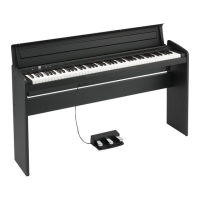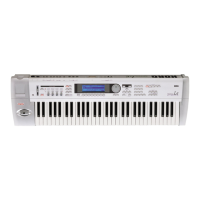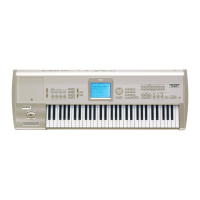Sequencer mode
202
Input [Analog, S/P DIF, (FireWire)]
Analog: The INPUT 1 and 2 jacks will input mic level or line
level signals.
S/P DIF: A digital audio from the S/P DIF IN jack will be
input. Connect the digital output of your instrument or DAT
etc. to the S/P DIF IN jack. The S/P DIF input/output
supports 48 kHz sample rates.
If you want to use S/P DIF, set System Clock to S/P
DIF. For more information, please see “System Clock”
on page 359.
FireWire: If the EXB-FW option is installed, input a digital
audio signal from the FireWire connector. The sample rate of
the FireWire input/output is 48 kHz.
Input1, Input2:
PLAY/MUTE [PLAY, MUTE]
SOLO On/Off [Off, On]
Level [000...127]
Pan [L000...C064...R127]
Bus Select [L/R, IFX1...5, 1...4, 1/2, 3/4, Off]
FX Bus (FX Control Bus) [Off, 1, 2]
AUX Bus [Off, 1, 2, 3, 4, 1/2, 3/4]
Send1 [000...127]
Send2 [000...127]
Here you can specify the input source for the analog and
digital audio inputs, and set the input level, pan, buses, and
the send levels to the master effects. These input settings are
valid when User Global Setting is turned off.
These parameters are the same as in Program mode P0:
Play– Sampling/Audio In page. For more information,
please see “0–7a: Audio Input” on page 9.
ADC OVERLOAD !
For more information, please see “0–7a: Audio Input” on
page 9.
0–1–7b: Sampling Setup
Here you can select the source to be sampled, and the
method by which to initiate sampling.
Except for Trigger, the following parameters are the same as
in the Program mode P0: Play– Sampling/Audio In page.
For more information, please see “0–7b: Sampling Setup” on
page 10.
“Sampling Setup” settings are maintained not separately for
each song, but as a single set in Sequencer mode.
Source Bus [Analog Input1/2, S/P DIF IN L/R,
(FireWire IN L/R), L/R, AUX1/2,
AUX3/4, Indiv.1/2, Indiv.3/4]
Trigger [Sampling START SW, Note On,
Threshold, Sequencer START SW]
Specifies how sampling will be initiated.
Sampling START SW: Pressing the SAMPLING REC switch
will cause the M3 to enter sampling-standby mode, and
sampling will begin when you press the SAMPLING
START/STOP switch.
Note On: Press the SAMPLING REC switch, and then press
the SAMPLING START/STOP switch to enter sampling-
standby mode. Sampling will begin when you play the
keyboard.
You can also initiate sampling by receiving a MIDI
note-on message instead of playing the keyboard.
Threshold: Sampling will begin automatically when the
input level exceeds the specified Level value. For more
information, please see “Trigger” on page 305.
Sequencer START SW: Press the SAMPLING REC switch
and then the SAMPLING START/STOP switch to enter
sampling-standby mode. Then press the SEQUENCER
START/STOP switch to begin sampling. Use this when you
want to resample the song playback.
To stop sampling, press the SAMPLING START/STOP
switch once again. Sampling will also end if you keep
sampling until the time specified by Sample Time. For more
information, please see “Trigger” on page 305.
Threshold Level [–63 dB...00dB]
When sampling with Trigger set to Threshold, this specifies
the level at which sampling will begin. This can be set only
when Trigger is set to Threshold. See step 3 of the Trigger
Threshold procedure. For more information, please see
“Trigger” on page 305.
Save to [RAM, MEDIA]
Mode (Sample Mode) [L-Mono, R-Mono, Stereo]
Sample Time [min sec]
For more information, please see “0–7b: Sampling Setup” on
page 10.
0–1–7c: Recording Level [dB]
This adjusts the signal level at the final stage of sampling.
The default setting is 0 dB.
Recording Level [–Inf, –72.0 ... +0.0 ... +18.0]
Level Meter
CLIP !
These parameters are the same as in Program mode P0:
Play– Sampling/Audio In. For more information, please see
“0–7c: Recording Level [dB]” on page 13.
The Recording Level setting is not saved per song; it is a
single setting for Sequencer mode.
▼0–1–7: Menu Command
• 0: Memory Status ☞p.271
• 1: Panel–SW Solo Mode On ☞p.106
• 2: Exclusive Solo ☞p.107
• 3: Rename Song ☞p.271
• 4: Delete Song ☞p.271
• 5: Copy From Song ☞p.271
• 6: Load Template Song ☞p.271
• 7: Save Template Song (Save as User Template
Song) ☞p.272
• 8: FF/REW Speed ☞p.272
• 9: Set Location (Set Location for Locate Key) ☞p.272
• 10: GM Initialize ☞p.273
• 11: Copy From Combi (Copy from
Combination) ☞p.273
• 12: Copy from Program ☞p.273
• 13: Copy X–Y Motion ☞p.107
• 14: Optimize RAM ☞p.107
• 15: Select Bank & Sample No. ☞p.108
(only Save to RAM)
• 15: Select Directory ☞p.108 (only Save to MEDIA)
• 16: Auto Sampling Setup ☞p.109

